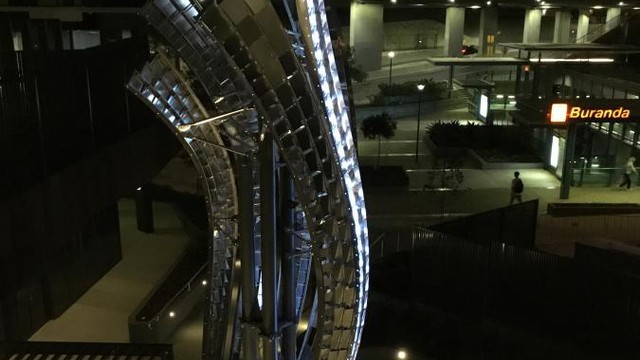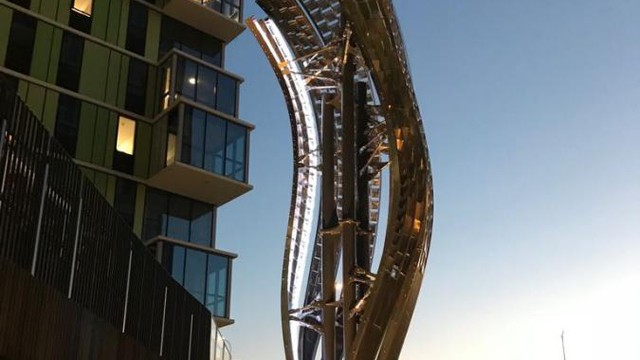LightLines 2018, Australia, Buranda, Brisbane
Lightlines: a site-responsive kinetic and lighting artwork






Lightlines draws from research into a rich & entwined history of transportation & community in Buranda. The art is influenced by the site’s distant & modern histories. Lightlines crystallises around notions of time, timetables, journey & responds to the indigenous word Buranda -windy place & an older history of agriculture. These ideas are realised through the materiality & visual language of the work. Lightlines is part kinetic-part light; designed to offer unique viewing experiences. The daylight & air movement generates fluid, elusive moments in the day & the night lighting design draws attention to the construct of time; expressed via a lighting sequence that offers a visually poetic clock marking off time in 5-minute intervals.
Lightlines draws from research into the rich history of transportation & community in Buranda. The site’s history is expressed through the materiality & visual language of the work. Lightlines is part kinetic-part light. The daylight & air movement generates fluid, elusive moments in the day & the night lighting design draws attention to the construct of time; expressed via a visually poetic clock marking off time in 5-minute intervals. Our practice resides in ideas of interstitial moments & a desire to capture, extended, express these moments. Lightlines emerged from a multi-faceted approach to thinking about the site, taking inspiration & making connects to the location via multiple layers & paces of time; layers of geological & social time As well as more esoteric ideas of life-lines, journeys, transformation, & transition. The artwork starts as multiple routes running from the outer edges to the central sculptural element. Suggesting roads & rails, these 6 routes represent the now lost Brisbane tram network, flow along the ground & up into the air. The lighter flutter stainless steel elements take the artwork up to its full 12m height. These respond to the omnipresent elements of wind & sunlight generating flickers & flashes of light, thus creating an immediacy & aliveness that reflects the essence of inner-city life. At night the lighting brings a new layer of time-based expression. Inspired by the main modes of transportation intersecting Buranda: cars, buses, rail, the light lines echo lines captured in time-lapse images of vehicles at night. The lighting is integrated into the routes of each element, in a sequence that creates a visually poetic clock marking off time in 5-minute intervals. The overall design also hints to a ghost tree - playing on the phonetics of the word route to engender roots and place; acknowledging the geological time of the landscape that makes up Place.
http://davisthomas.com.au/works/public-commissions/lightlines
Details
Building or project owner : Wee Hur (Buranda TOD) / davisthomas built the artwork
Project artist/ concept/ design/ planning : davisthomas
Structural engineering : Ian Barnes
Kinetic engineering : davisthomas
Light design : davisthomas
Technical layout light : albert smith group
Display content/ visuals/ showreel : davisthomas
Light hardware (LED hardware) : albert smith group
Lighting control software : albert smith group
Project co-ordination : davisthomas
Descriptions
Facade type and geometry (structure) : The lighting is built into the physical artwork - using small channels to reflect the light up and out into the local environment. The artwork is made up of: 316 electro-polished stainless steel elements, GFRC Concrete, mild steel, IP65 rated LED RGB, DMX lighting controllers. Dimensions: 12000mm x 4000mm x 4000mm
Kind of light creation : The lighting is a subtle & integral part of the visual nighttime experience. Bringing the audience to the ideas of time, timetables, journies. Working in a clockwise rotation the lighting design slowly brings up each route (one at a time) to its full light - holds for 5 minutes & then cross transitions to the next route, thus creating a 30min full rotation clock.
Resolution and transmitting behaviour : Starting from dusk, each route of the artwork is lit up for a 5 minute period then crossfaded to the next in a clockwise fashion. The lux levels are in keeping with the broader lighting design to be visually present but not overtly impactful. The idea is for cafe/bar patrons to use the work to keep a sense of time, in combination with catching transport at the stations.
Urban situation : The artwork is situated in an Urban Village development with 32 story multi-use residential, retail and transport hub. Buranda is in an inner-suburb of Brisbane City.
Description of showreel : please see images of the work at: http://davisthomas.com.au/works/public-commissions/lightlines
Participatory architecture & urban interaction
Community or communities involved : The work did not involve community engagement as there is no current community at the location. However, the research and subsequent work reflects the social and geological histories of the location. Additionally, Queensland University Technolgy students were invited to explore our unique large-scale practice studio as part of their learning opportunities.
Host organization : davisthomas
Issues addressed : How do we create a sense of place - a micro identity for an urban village within the context of a larger city landscape? and equally, how do we generate a sense of Place out of greenfield development?
Impact : By highlighting the rich layers of location history of this 'greenfield' site, the project is a start point in community-led identity creation. Through designing a unique site-responsive artwork for Buranda, we hope to support the Urban Village Development to generate its own sense of Place.
Next steps : The work is located in Buranda for a 20year period.
Mediacredits
davisthomas, Lightlines, 2018.
davisthomas, Lightlines, 2018.
davisthomas, Lightlines, 2018.
davisthomas, Lightlines, 2018.
davisthomas, Lightlines, 2018.
davisthomas, Lightlines, 2018.